Key takeaways:
- Homelessness is a complex issue influenced by economic, social, and mental health factors, requiring empathy and actionable change.
- Charitable contributions not only provide essential resources but also foster hope and community interconnectedness.
- Effective fundraising can be achieved through community events, engaging storytelling, and leveraging social media for broader outreach.
- Building partnerships with local businesses and schools enhances support for homelessness initiatives and engages the community effectively.
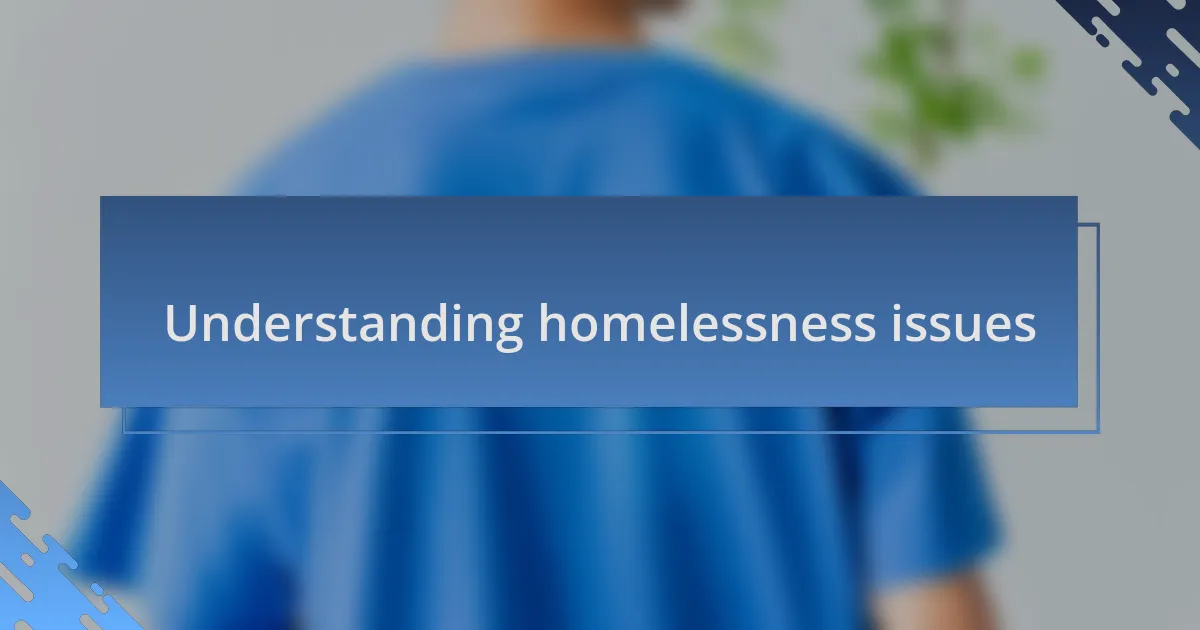
Understanding homelessness issues
Homelessness is a complex issue that touches on various aspects of society, from economic instability to mental health challenges. I remember a time when I volunteered at a local shelter, and it became evident that each person’s story was uniquely shaped by circumstances beyond their control. Why do we often overlook their humanity, reducing them to mere statistics?
One aspect that often leaves me pondering is the invisible barriers that people experiencing homelessness face daily. For instance, a simple lack of access to proper identification can prevent someone from securing employment or housing. It’s a cycle that can feel overwhelmingly disheartening—have we considered how small societal changes could dismantle these barriers?
Moreover, the stigma surrounding homelessness can be as detrimental as the condition itself. I once spoke with an individual who shared that the most painful part of his experience was the isolation he felt from the community. How can we work towards dismantling these misconceptions and fostering a sense of belonging for all? Addressing homelessness requires empathy and understanding, combined with actionable steps to create real change.
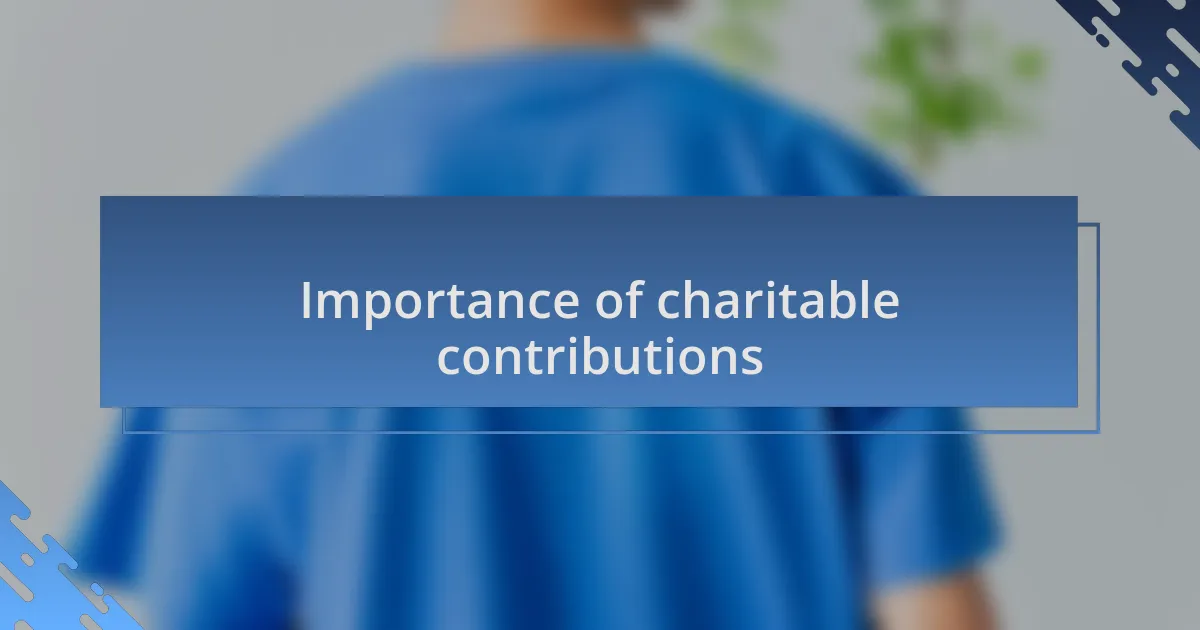
Importance of charitable contributions
Charitable contributions serve as a lifeline for those experiencing homelessness, providing critical resources that can transform lives. I recall attending a fundraising event where we surpassed our goal, allowing the charity to expand its outreach programs significantly. It’s moments like those that highlight how generosity can create tangible change in the community—don’t we all want to be part of something that uplifts others?
The impact of donations extends beyond mere financial support; they foster hope and resilience among individuals facing homelessness. I once met a woman who had received assistance from a charity, enabling her to find stable housing and employment. Listening to her story was a powerful reminder of how the kindness of strangers can ignite a spark of hope—what if our small contributions could make an enormous difference in someone’s journey?
Moreover, the act of giving cultivates a sense of interconnectedness within our communities. It’s heartwarming to witness how people come together for a shared cause, breaking down barriers and building compassion. Have you ever participated in a volunteer event? The camaraderie felt among volunteers reminds us that we’re all part of the same human tapestry, reinforcing the idea that together, we can make an impact that resonates well beyond the immediate moment.
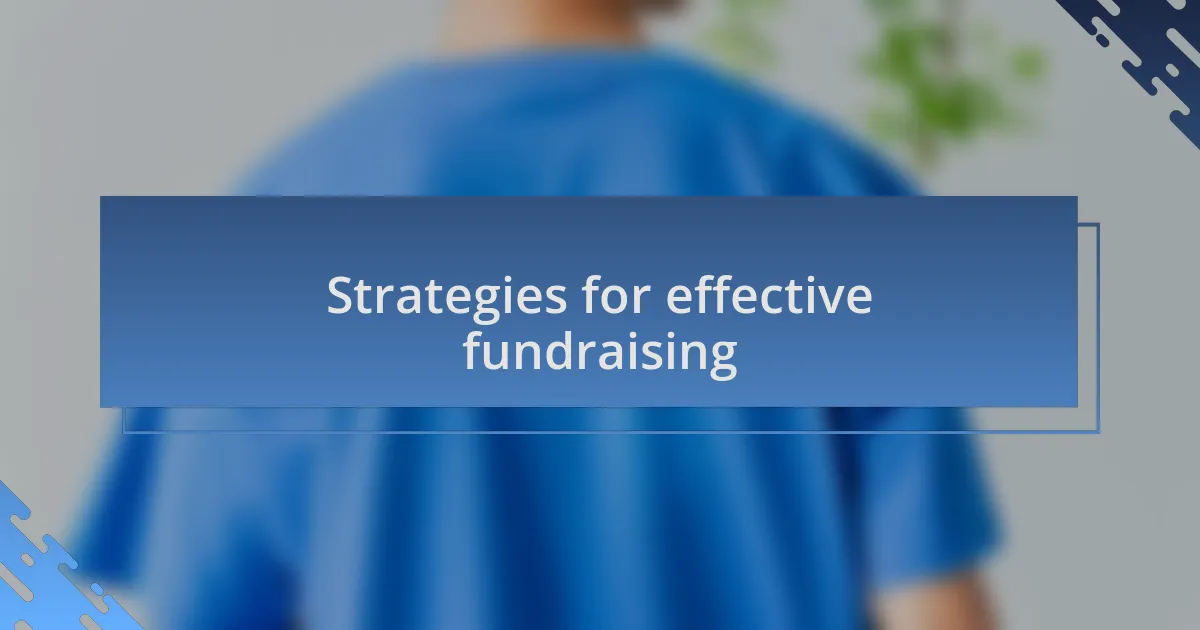
Strategies for effective fundraising
One effective strategy for fundraising is organizing community events that engage local supporters. I once helped plan a charity run that not only raised funds but also brought the community together, fostering a strong spirit of teamwork. When folks see their friends and neighbors hustling for a cause, it creates an atmosphere of excitement—who wouldn’t want to join in on something that has a palpable energy behind it?
Engaging storytelling is another powerful tool in the fundraising arsenal. I remember vividly sharing the story of a young man who found his footing after receiving support through our organization. His journey captured hearts and prompted donations that far exceeded our expectations. How can we forget that sometimes it’s the personal connection to a story that inspires generous giving?
Lastly, leveraging social media can amplify fundraising efforts immensely. I often share updates and unique challenges online, encouraging supporters to not only donate but also to spread the word. When I see someone share our posts or urge their friends to contribute, it makes me wonder—could one shared story ripple through a network and reach those who might be on the fence about donating? The potential for community-wide engagement is limitless.
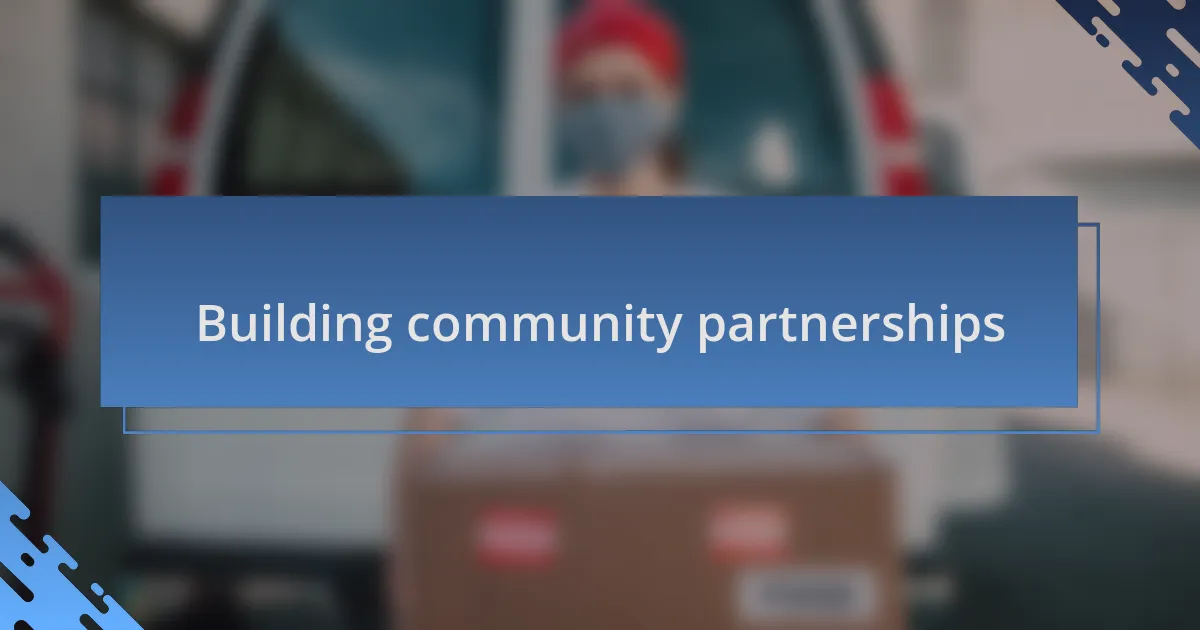
Building community partnerships
Building community partnerships is essential for the success of any homeless charity. In my experience, collaborating with local businesses can create mutually beneficial relationships. Once, I approached a nearby café, and they agreed to host a fundraising night where a portion of the profits went directly to our cause. The café not only increased its clientele that evening but also strengthened its ties with the community. Isn’t it amazing how a simple partnership can transform a night into something meaningful for both the charity and the local business?
Moreover, involving local schools in your efforts can amplify your impact. I recall when we partnered with a high school for a service project that engaged students in collecting supplies for our shelter. The students were not only eager to help but also learned valuable lessons about empathy and community responsibility. Thinking about it now, how often do we overlook the potential of young voices in rallying support for those in need? Their energy and enthusiasm can ignite a spark that resonates throughout the entire community.
Finally, I’ve found that grassroots efforts can lead to powerful partnerships. By attending neighborhood meetings and connecting with local leaders, I was able to identify key stakeholders who truly care about the issue of homelessness. I remember one particular meeting where a resident shared their own story of hardship, bridging a connection that resulted in ongoing support for our programs. This experience taught me that genuine relationships often come from authenticity—how can we foster these connections to elevate community support for homeless individuals?
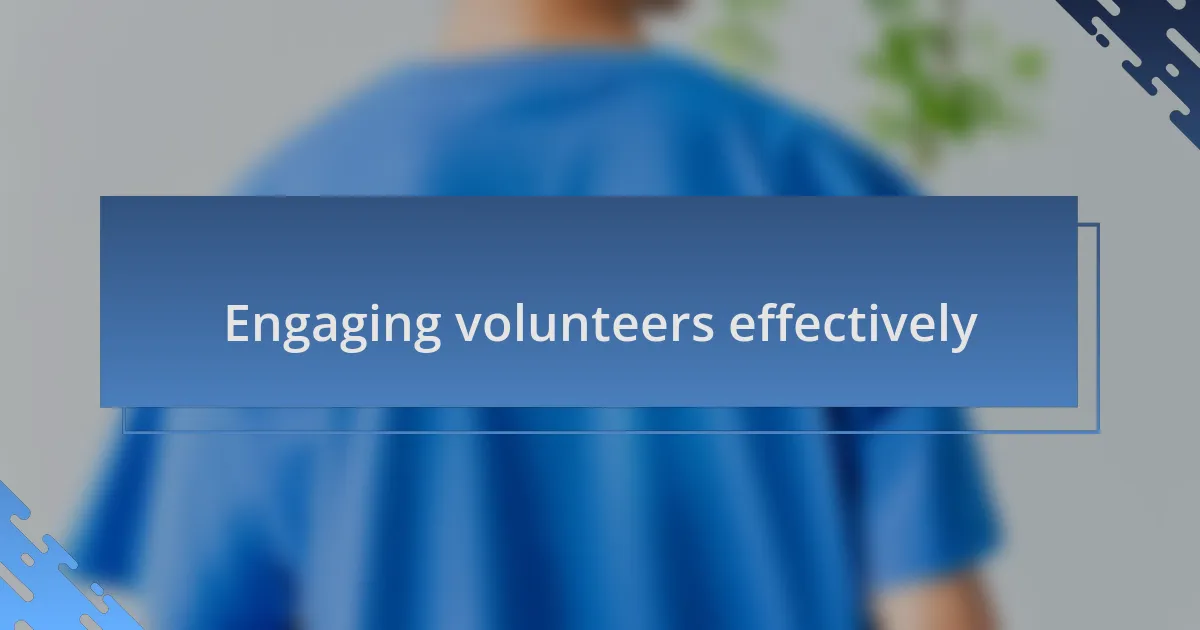
Engaging volunteers effectively
Engaging volunteers effectively starts with creating a welcoming environment that makes them feel valued. I’ll never forget the first time I welcomed a group of new volunteers at our shelter. Instead of jumping into tasks, I spent time sharing stories of those we serve, and it sparked a real connection. Hasn’t anyone ever noticed how stories can break down barriers and foster a sense of purpose?
Communication is vital in this process. I learned that being transparent about what volunteers can expect helps set the right tone for their experience. For instance, I sent regular newsletters detailing our achievements and challenges, which kept everyone in the loop. When volunteers feel informed and included, they’re more likely to stick around and contribute their talents creatively. Have you ever thought about how a simple newsletter could inspire action and dedication?
Lastly, recognizing and celebrating volunteer achievements can have a profound effect on their engagement. For example, we had a small event to honor volunteers who reached significant milestones, and the joy on their faces was unforgettable. It made me realize that appreciation fosters loyalty and encourages even more involvement. How might a little recognition turn a one-time volunteer into a committed advocate for your cause?

Leveraging social media outreach
Social media outreach has become an essential tool in raising awareness for homeless charities. I remember a campaign we initiated on Instagram, where we invited our followers to share their thoughts on what home means to them. The flood of heartfelt responses not only increased our visibility but also created an emotional connection with the community—something that goes beyond mere statistics. Have you ever considered how social media can turn abstract concepts into relatable stories?
Engaging with followers on platforms like Facebook and Twitter allows for genuine interaction. I recall a time when we held a live Q&A session to discuss our mission and the challenges faced by those experiencing homelessness. The dialogue that emerged was powerful; people asked tough questions, shared their own experiences, and even offered volunteer opportunities. Can you imagine the impact of real conversations that break down misconceptions and foster empathy?
Utilizing user-generated content can create an authentic narrative around your cause. I once encouraged our supporters to share photos from a fundraising event using a specific hashtag. The result? A vibrant collage of joyful moments that not only showcased our community’s spirit but also attracted new donors and volunteers. How might harnessing the power of your audience’s stories amplify your reach and influence?
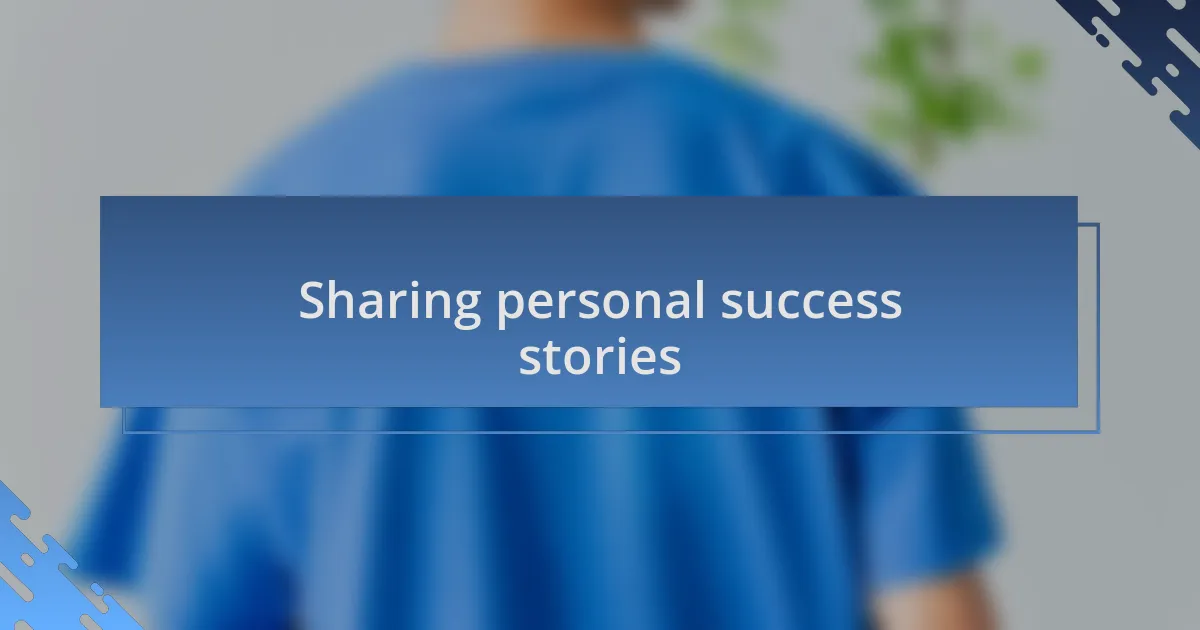
Sharing personal success stories
Personal success stories can transform perceptions and inspire action. I once met a former client who, after receiving support from our charity, went on to start his own business. Hearing his journey—from living on the streets to becoming a self-sufficient entrepreneur—brought tears to my eyes. Isn’t it incredible how one person’s triumph can ignite hope in others?
When we share these stories, we allow potential donors and volunteers to see the tangible impact of their contributions. I vividly remember a woman who shared her experience of overcoming addiction with the aid of our program. Her words resonated deeply with our audience, often prompting discussions that led to greater community involvement. How often do we underestimate the power of a single voice when it comes to inspiring change?
Incorporating personal success narratives can make our outreach more relatable and compelling. I’ve noticed that when we celebrate our clients’ milestones—whether it’s securing housing or graduating from a vocational program—it not only highlights their resilience but also reminds everyone why our mission matters. Why do we typically focus on data rather than personal experiences? Stories humanize the statistics, making them more memorable and powerful for everyone involved.